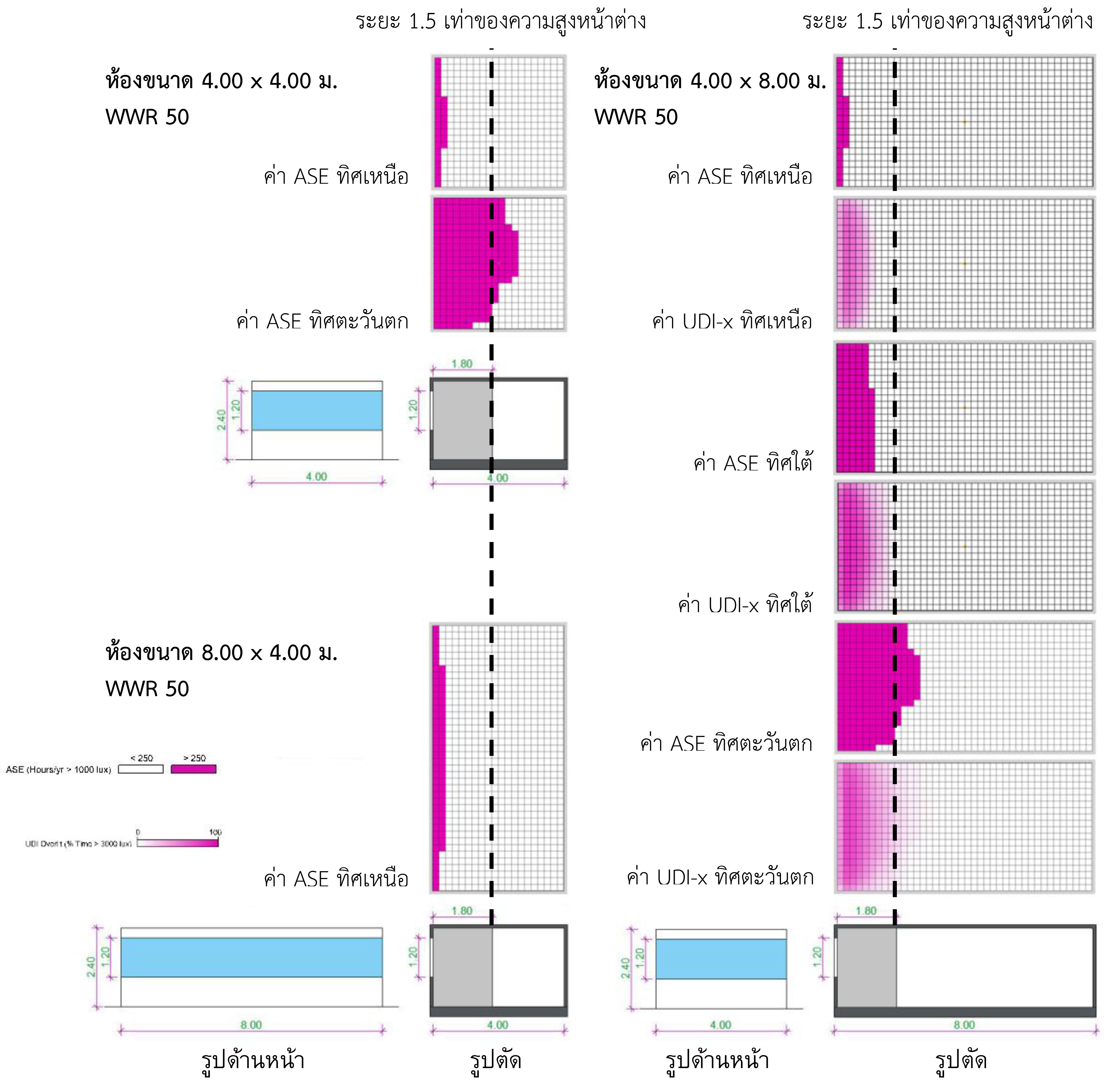Guidelines and Applications of Daylight Metrics for Buildings in Thailand
Main Article Content
Abstract
Due to the limit of static daylight analysis method, daylight factor, dynamic daylight analysis method or climate-based daylight modeling, i.e., sDA, UDI, ASE, was introduced. The new metric has been widely used to predict daylight performance that relates to local weather data. With this condition, the evaluation criteria of the buildings in each location should be specified. The main focus of this research paper was the performance analysis of daylight metrics for building in the context of Thailand. The scope of the research is delimiting a study by one-sided opening, room dimensions, window-to-wall ratio, orientation, and Bangkok weather data. Simulation software was used throughout the research. The representative rooms were modeled by Rhinoceros 5. All cases were simulated and explored by Grasshopper and DIVA for Rhino v.4.1.0.8. The results of the research showed that the climate-based daylight analysis method was highly recommended because it can provide more variously useful information than a static method. Compared with the other metrics, the use of UDI, i.e., UDI-a and UDI-x, were suggested as a reasonable tool to assess daylight performance in building, in terms of quality and quantity. However, it is very especially important for researchers and architects to develop and optimize the use of new metrics in Thailand.
Downloads
Article Details

This work is licensed under a Creative Commons Attribution-NonCommercial-NoDerivatives 4.0 International License.
All material is licensed under the terms of the Creative Commons Attribution 4.0 International (CC-BY-NC-ND 4.0) License, unless otherwise stated. As such, authors are free to share, copy, and redistribute the material in any medium or format. The authors must give appropriate credit, provide a link to the license, and indicate if changes were made. The authors may do so in any reasonable manner, but not in any way that suggests the licensor endorses you or your use. The authors may not use the material for commercial purposes. If the authors remix, transform, or build upon the material, they may not distribute the modified material, unless permission is obtained from JARS. Final, accepted versions of the paper may be posted on third party repositories, provided appropriate acknowledgement to the original source is clearly noted.
References
Ashdown, I. (2014). Daylight factors. Retrived June 10, 2019, from https://lightinganalysts.com/daylight-factors/.
Department of Energy Development and Efficiency (DEDE). (2007a). Evaluation of energy efficient and environmental friendly buildings manual: Public building]. Bangkok: Chulalongkorn University Press.
Department of Energy Development and Efficiency (DEDE). (2007b). Evaluation of energy efficient and environmental friendly buildings manual: Residential building. Bangkok: Chulalongkorn University Press.
Egan, M. D. & Olgyay, V. (2002). Architectural lighting (2nd ed.). New York: McGraw-Hill. Illuminating Engineering Society of North America.
Illunimating Engineering Society (IES). (2012). Approved Method: IES Spatial Daylight Autonomy (sDA) and Annual Sunlight Exposure (ASE). New York: Author.
International Well Building Institute. (2019). Daylight modeling. Retrieved Oct 8, 2019, from https://v2.wellcertified.com/v/en/light/feature/5
Kaufman, E. J. (Ed.). (1966). IES lighting handbook: The standard lighting guide (4th ed.). New York: Illuminating Engineering Society.
Kwok, G. A. & Grondzik, T. W. (2007). The green studio handbook: Environmental strategies for schematic design. New York: Architectural Press.
Mardaljevic J. (2017). Climate-based daylight modelling. Retrived Jan 22, 2019, from http://www.climate-based-daylighting.com/doku.php?id=academic:climate-based-daylight-modelling
Mardaljevic J., Heschong, L., Lee, E. S. (2009). Daylight metrics and energy savings. Lighting Research and Technology 2009. (0) : 1-23.
Nabil A, Mardaljevic J. (2005). Useful Daylight Illuminance: A new paradigm to accessing daylight in buildings. Lighting Research and Technology. 37(1) : 41-59.
Nabil, A. & Mardaljevic J. (2006). Useful Daylight Illuminances: A replacement for daylight factors. Energy and Buildings. 38(7): 905-913.
Reinhart, C., F., Mardaljevic, J., Roger, Z. (2006). Dynamic daylight performance metrics for sustainable building design. Leukos. 3(1): 7-31
Roache, L. (2002). Summertime performance of an automated lighting and blinds control system. International Journal of Lighting Research and Technology, 34(1): 11-25.
Royal Thai Government Gazette. (2009). Ministerial regulation prescribing type or size of building and standard, criteria and procedure in designing building for energy conservation B.E. 2552. 126 (12a), dated 20 Febuary 2537, 9-15.
Sreshthaputra, A. (2013). Ecovillage evaluation manual: NHA. Bangkok: .Papermate (Thailand).
Stein, B. & Reynolds, S. J. (2000). Mechanical and electrical equipment for buildings (9th ed.). New York: John Weily & Sons.
Thai Green Building Institute(TGBI). (2012). Thai’s Rating of Energy and Environmental Sustainability for new constrution and major renovation. Bangkok: Author.
U.S. Green Building Council (USGBC). (2019). LEED v4.1. Retrived June 10, 2019, from https://new.usgbc.org/leed-v41#bdc.


